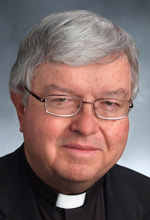Q. Recently, I listened to Mel Gibson being interviewed about the making of his film, “The Passion of the Christ.” He referred to the visions of a certain Anne Catherine Emmerich. That prompted me to read more about those visions, which I found to be inspiring and, frankly, life-changing. What is the Catholic Church’s stance on Emmerich? Is she a candidate for sainthood? (Atlanta)
A. Blessed Anne Catherine Emmerich, a Catholic nun, was a member of the Augustinian order who lived in Germany and died in 1824 at the age of 49. She was beatified by Pope John Paul II in 2004 after a miracle was documented through her intercession. She was a mystic, a person drawn to deep prayer from an early age, and regularly experienced visions in which she felt herself talking directly with Jesus.
She was also a stigmatic who bore on her body the wounds of the crucified Christ. Sister Emmerich suffered from a debilitating illness, spending much of her adult life bedridden and in persistent pain, and she offered her suffering in union with that borne by Jesus. Those who were sick regularly asked for her prayers.
Mel Gibson has said that he based much of his 2004 film, “The Passion of the Christ,” on the visions of Sister Emmerich as reported by the poet Clemens Brentano in a book called “The Dolorous Passion of Our Lord Jesus Christ According to the Meditations of Anne Catherine Emmerich.”
Brentano wrote the book after extensive interviews with Sister Emmerich. The controversy regarding Sister Emmerich, in large part, surrounds the writings of Brentano, which are considered by most experts to be unreliable, filled with pious fabrications and poetic elaborations. There is also, in Brentano’s work, a strong anti-Semitic strain; he portrays Jews not only as obsessed with torturing Christ but also with killing Christian children and using their blood in demonic rituals.
When Sister Emmerich was beatified in 2004, it was made clear by the Vatican that the church’s judgment was based on her personal life and sanctity, and not at all on Brentano’s writings, which the Vatican announced that it was setting aside due to their questionable authenticity.
Q. Having seen references in a book I read to something called “centering prayer,” I decided to learn more — and now I’m quite confused. A number of websites, which identify themselves as Catholic, condemn centering prayer as dangerous or even heretical. But I’ve also heard that centering prayer was developed and promoted by some Catholic priests. So I have two questions. First, is centering prayer a good thing or a bad thing? And if it’s acceptable, then why do people object to it so strongly? (Finksburg, Md.)
A. Centering prayer is a method of Christian contemplation that places a strong emphasis on interior silence. The aim is to forego all thoughts and images to experience the direct presence of God.
It grew popular in the 1970s and 1980s, particularly through the writings of three Trappist monks from St. Joseph’s Abbey in Spencer, Mass.: Abbot Thomas Keating, Father Basil Pennington and Father William Meninger. (A book written by Father Pennington in 1980, “Centering Prayer: Renewing an Ancient Christian Prayer Form,” was published in several languages and sold more than one million copies.)
Some critics claim that centering prayer blurs the distinction between the creator and the created and borders on pantheism, with the belief that we are all connected to an impersonal energy force that is divine. In 1989, the Vatican’s Congregation for the Doctrine of the Faith issued a document entitled, “On Some Aspects of Christian Meditation.” It warned of potential dangers in blending Christian prayer with Eastern methods of meditation — although it never specifically mentioned centering prayer.
The guidelines for centering prayer invite the user to sit quietly with eyes closed, choose a sacred word as a gently present anchor (“Jesus,” perhaps, or “Abba”) and focus not on any discursive thoughts but solely on one’s desire to be in the presence of the Lord and open to any divine promptings.
No doubt there are people who can do that in a way that is theologically orthodox — not with an amorphous “melting into God” but with the consciousness of one’s own frailties in the face of God’s majesty.
One needs to remember, though, that the true contemplative experience of God in prayer comes only as a gift and can never be guaranteed by any particular technique.
***
Questions may be sent to Father Kenneth Doyle at askfatherdoyle@gmail.com and 40 Hopewell St., Albany, N.Y. 12208.
PREVIOUS: Mass just too long? There are answers, and options
NEXT: The trials of travel point to our ultimate destination




I have read Blessed Anne Catherine Emmerich”s book and I go back and re-read passages in order to focus on the Passion of Christ. Thank you for your comments. Do you think Pope Francis will canonize her?
Do I think Pope Francis will canonize her? I think it’s more likely that he will canonize Che Guevera.